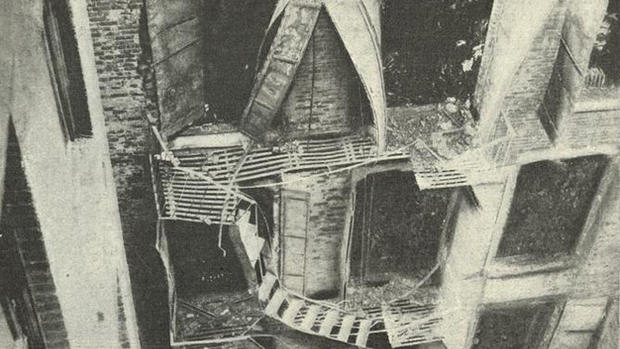March 25, 1911: Triangle fire tragedy kills 146 factory workers
A beautiful spring afternoon in New York City turned tragic when a factory fire broke out on the top floors of a Greenwich Village building on March 25, 1911.
The Triangle Shirtwaist Factory occupied the top three floors of a ten story building. About 500 women, mostly young Italian and Jewish immigrants, worked there for about $15 a week -- 146 did not make it out alive.
"Each one came to America in the hope of a better life," said Annie Polland, a Senior Vice President at the Lower East Side Tenement Museum. "Each one was probably supporting other family members. So the loss was almost, it was incalculable."
It's unclear exactly what started the fire, but it's believed that someone dropped a match or cigarette.
The door leading to the outside was locked -- some think the factory owner locked it to keep union organizers out. There was reportedly only one small working elevator, and no sprinkler system. The fire escape quickly broke under the weight of desperate workers trying to flee.
The women were trapped.
Firefighters arrived quickly on scene, but their ladders only reached the sixth floor, and their nets turned out to be too weak to catch women jumping from the windows.
Bystanders watched in horror as women leapt to their deaths, with very little they could do to help. The tragedy took a lasting toll on the city of New York -- and the public outcry led to government action to prevent another horrific inferno.
"This fire really shook people up," researcher Michael Hirsch told CBS News' Michelle Miller in 2011, the 100th anniversary of the fire.
"The city was so guilt-stricken. Everyone knew something was wrong, there was something wrong with that building and that maybe we were somehow responsible. And it led to all these reforms that came after."
The state of New York passed more than 36 new laws within a few years of the fire. The reforms included better fire and safety regulations as well as child labor laws -- since many of the Triangle workers were just teenagers.
One fire witness, Frances Perkins, went on to be Franklin D. Roosevelt's Secretary of Labor for 12 years. She became a champion for labor unions and worker rights, as well as minimum wage laws.
Tributes and memorials pop up every year, even 105 years later. In 2004, an artist from New York named Ruth Sergel came up with her own way to remember the victims.
"I just emailed a bunch of my friends and asked them if they would be willing to go to the homes of the victims and write the names and ages of the Triangle workers in front of their former homes, to make a public memorial of our own," Sergel said of the tradition, which locals call "chalking the victims."
Fourteen-year-old Josie Ingall lives in the East Village with her mother, and has been chalking since she was seven. Every year they go to the home of the youngest victim, a 14-year-old girl who was named Kate.
It's the kind of thing Hirsch told Miller in 2011 that he was committed to doing. He took it upon himself years ago to learn the stories of all 146 victims. He even connected with some of their family members -- often telling them for the first time they were related to someone who died in the fire.
It's important, he said, to remember who these people were and the lasting impact they had on the country.
"Their sacrifice, that terrible death, is the thing that really motivated people to start thinking about doing things differently in this country. So in a way, they are kind of heroes. I look at it that way."


